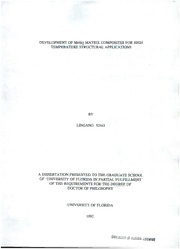
Development of MoSi₂ matrix composites for high temperature structural applications PDF
Preview Development of MoSi₂ matrix composites for high temperature structural applications
DEVELOPMENTOFMoSi2MATRIXCOMPOSITESFORHIGH TEMPERATURESTRUCTURALAPPLICATIONS BY LINGANG XIAO ADISSERTATIONPRESENTEDTOTHEGRADUATESCHOOL OF UNIVERSITYOFFLORIDAINPARTIALFULFILLMENT OFTHEREQUIREMENTSFORTHEDEGREEOF DOCTOROFPHILOSOPHY UNIVERSITYOFFLORIDA 1992 UWtfSITYOFFLORIDALIBRARIES ACKNOWLEDGMENTS I would like to express my sincerest gratitude to Dr. R. Abbaschian, my supervisory committee chairman, for his invaluable guidance, support and encouragementthroughouttheresearchportionofthisproject, andforhisnumerous suggestions and corrections during the preparation of this dissertation. I am also thankfultotherestofmycommitteemembers,Dr.R.T.DeHoff,Dr.M.J.Kaufman, Dr. J. Mecholsky and Dr. B. V. Sankar, for their encouragement and advice throughouttheresearchofthisproject. Theauthorwouldalsoliketoacknowledgethe supportofthisprojectfromtheDARPAandONRthroughgrantNOOO14-9l-J-4075. Iwouldalsoliketoextendmythankstomycolleagues,Dr.A.B.Gokhale,Dr. Y. S. Kim, Mr. I. H. Hwang and Mr. L. Lu, with whom I had many fruitful discussionsonvariousaspectsofthisresearch. Specialthanksmustalsobegivento Mr.WayneAcreeforhishelpfuldiscussionsonelectronmicroscopyanalyses.Thanks arealsoduetoDr.D.E.ClarkandMs.D.C.Folzforhelpingmetostartthesol-gel coatingtechnique. Finally, Iamdeeplyindebtedtomyparentsfortheirloveandencouragement throughout my entire life, and to my loving wife and daughter for their patience, understanding,inspirationandsupportduringthecourseofthiswork. u TABLEOFCONTENTS Pages ACKNOWLEDGMENT ii ABSTRACT v CHAPTER 1.INTRODUCTION 1 2.LITERATURESURVEY 6 2.1TheoreticalBackground 6 2.2TougheningMechanismsinBrittleMatrixComposites 9 2.3DuctilePhaseToughening 22 2.4PhysicalandChemicalPropertiesofMoSi2matrix 28 3.EXPERIMENTALPROCEDURE 31 3.1MicrostructuralCharacterizationandRawMaterials 31 3.2FiberandFoilCoatingTechniques 33 3.3FabricationofMoSi2MatrixComposites 35 3.4MeasurementofIntrinsicPropertiesoftheDuctilePhase 36 3.5MeasurementofFractureEnergyofMatrix/Reinforcement Interface 38 3.6MeasurementofToughnessoftheComposites 38 4.RESULTSANDDISCUSSION 41 4.1MicrostructuresoftheComposites 41 4.1.1MonolithicMoSi2 41 4.1.2MoSi2/uncoatedNbInterface 44 4.1.3ChemicalCompatibilityofCoatingMaterialswith NbandMoSi2 53 4.1.4EffectivenessoftheInertCoatingsasaDiffusionBarrier 55 4.2OptimizationofCoatingProcesses 61 4.2.1CoatingviaSol-GelTechnique 62 4.2.2CoatingviaPhysicalVaporDeposition 66 4.2.3CoatingviaHotDippingandAnodizingTechnique 69 4.3FractureEnergyoftheMatrix/ReinforcementInterfaces 74 4.3.1MoSi2/UncoatedNbInterface 74 iii 4.3.2MoSi2/Al203coatedNbinterface 75 4.3.3MoSi2/Zr02coatedNbinterface 85 4.4InteractionsbetweenCracksandDuctileReinforcements 86 4.4.1RelationbetweentheExternalLoadandCrack PropagationinMoSi2/Nbcomposites 88 4.4.2BehaviorsofCracksattheInterface 94 4.4.3FractureSurfaceObservationonMoSi2Matrix 105 4.5FlowBehaviorofConstrainedNiobium 107 4.5.1IntrinsicPropertiesoftheProcessedNb 110 4.5.2FailureMechanismandRelatedObservationon ConstrainedNiobium 114 4.5.3Stress-DisplacementCurvesofConstrainedNiobium 120 4.5.4ModelingofFlowBehavioroftheConstrainedNiobium.... 123 4.5.5ComparisonbetweentheModelandExperiments 128 4.6EffectsofInterface,SizeandOrientationofDuctilePhaseson Toughness 137 4.6.1Dual-EffectsoftheMatrix/ReinforcementInterfaceon theToughnessoftheComposites 137 4.6.2EffectsofNiobiumSizeontheToughness 141 4.6.3EffectsofOrientationofNiobiumLaminaontheToughness 146 4.6.4StressAnalysisofChevronNotchedSpecimensofthe MoS^/NbLaminatedComposites 151 4.6.5ComparisonbetweentheExper—imentsandAnalyticalResults 156 4.7ModelingofDuctilePhaseToughening LargeScaleBridging 159 4.7.1BasicModel 160 4.7.2ComputationoftheCrackGrowthResistance 163 4.7.3TypicalR-CurveBehaviorofDuctile-Phase- ToughenedComposites 164 4.7.4PredictionoftheEffectsofMatrix/Reinforcement InterfaceonToughness 170 4.7.5PredictionoftheEffectsofSizeofDuctilePhases onToughness 170 4.7.6PredictionoftheEffectsofIntrinsicPropertiesof DuctilePhasesonToughness 174 4.7.7PredictionoftheEffectsofVolumeFractionofDuctile PhasesonToughness 174 4.7.8PredictionoftheEffectsofPropertiesofMatrixon ^ Toughness 5.CONCLUSIONS 1Q_ APPENDIX REFERENCES BIOGRAPHICALSKETCH IV AbstractofDissertationPresentedtotheGraduateSchooloftheUniversityofFlorida inPartialFulfillmentoftheRequirementsfortheDegreeofDoctorofPhilosophy DEVELOPMENTOFMoSi2MATRIXCOMPOSITESFORHIGHTEMPERATURE STRUCTURALAPPLICATIONS By LingangXiao December1992 Chairman:Dr.RezaAbbaschian MajorDepartment:MaterialsScienceandEngineering Ductilephase toughening ofMoSi2 matrix reinforced with Nb filaments or laminaeforhightemperaturestructuralapplicationshasbeeninvestigated.Toimprove thehightemperaturestabilityofthecomposites,AI2O3coatingbetweenthematrixand reinforcementswasidentifiedasaneffectivediffusionbarrierandthermomechanically compatiblewithboththematrixand thereinforcements. Thetechniquesinvestigated forproducingtheAI2O3coatingonthesurfacesofniobiumreinforcementsincluded sol-gelprocessing, physicalvapordeposition, andhotdippinginamoltenaluminum followedbyanodizingtoformalumina. Theoptimizationofthesecoatingtechniques wasconductedandtheresultsindicatedthatthebestcoatingwasprovidedwithphysical vapordeposition,followedbythesol-geltechnique. In order to optimize the ductile phase toughening, the interactions between cracks and ductile reinforcements were examined. The effects of various material parameters, such as size of the ductile phase, bonding strength of the matrix/reinforcementinterface,andorientationoftheductilelaminaeonthetoughening werealsoexplored.Theexperimentalresultsindicatedthattheductilephasetoughening inthepresentsystemwaslarge-scalebridginginnature; thecrackgrowthresistance increasedwithsizeofductilephasesforlargeinitialcracks;ductile-laminae-reinforced composites provided a two-dimensional toughening; and the matrix/reinforcement interfaceexhibitedadual-effectonthetoughness,thatis,astronginterfacewouldgive risetoahighdamagetoleranceandlowworkoffracture,whileaweakinterfacewould provideahighworkoffractureandlowdamagetolerance. Based on the experimental observation, a rigorous analytical model was proposed todescribethelarge-scale-bridging (LSB) oftheductilephasetoughening. The LSB model allowed for the prediction ofthe typical R-curve behavior ofthe composites, encompassing the effects of the bonding strength of the matrix/ reinforcement interface, the size of ductile phases, and the intrinsic mechanical propertiesofthereinforcementandmatrix. TheLSB model, whichwasfoundtobe consistentwiththeexperimentalresults,providesaguidelineforthedesignofductile- phase-toughenedcomposites. VI CHAPTER 1 INTRODUCTION Theneedtoincreasetheoperatingtemperatureofheatenginestoimprovetheir efficiencyhasprovidedalargeimpetusin recentyears forthedevelopmentofhigh temperature structural materials such as carbides, nitrides, aluminides and silicides. Theseceramicsandintermetallics havevery high melting temperatures, high elastic moduli, low densities, and can withstand hostile environments. Their structural application,however,iscurrentlylimitedbytheirtendencytofailcatastrophicallyfrom smallsurfaceand/orinternalflaws,andbythermalshock. Accordingly, much effort has been made to improve the toughness ofthese materials. Two general approaches have received a great deal of attention: (1) increasing toughness through composite approaches (e.g., introduction ofa second phasein theform ofparticles, flakes, whiskers, fibers, oreven voids toproducea ceramic matrix compositeorintermetallic matrix composite); (2) reducing flaw size and population through improved processing (e.g., elimination of agglomerates, pressure sintering, etc.). Although significant improvements in minimizing strength- degradingdefectshavebeenachievedthroughimprovedprocessinginrecentyears,this approachisreachingitslimitation sincethecritical-sized flawscannotbeeliminated entirely. Incontrast, compositeapproacheshaveproved tobeeffectiveinimproving thetoughnessandhaveincreasedtheapparentfracturetoughnessofbrittlematerialsto usefullevels(about20MPa.m1/2). However, furtheradvancesareneededtodevelop ceramics and intermetallics with the desired level of reliability for structural applications. 1 2 It has been established that the mechanisms responsible for composite tougheningconsistofcrackdeflection, crackbowing, crackbridging, crackblunting and crack shielding (i.e., phase transformation toughening and microcracking toughening).Amongthesemechanisms,crackbridginghasbeenshowntobethemost effectivetoughening mechanism in the sensethat itcould increasethe toughness of compositestoausefullevelandprovidesuchtougheningatambienttemperaturesas well as at elevated temperatures. Crack bridging is achieved generally by the incorporation of ceramic whiskers or fibers, or ductile fibers or particles. Much exploration has been made in the area of ceramic fiber- or whisker-reinforced composites. For example, SiC whiskers have been used to reinforce alumina [1], mullite[2], silicon nitride [3-6], glass [7,8], magnesia-alumina spinel [9], zirconia [10,11], and mullite-zirconia [12,13]. ContinuousSiC fibers havealsobeen used to reinforcesiliconcarbide[14-17], siliconnitride[18]andglass[19], Oneofthemost importantfindingsinthebrittle-fiber-orwhisker-reinforcedbrittlematrixcompositesis thatabrittlematrixbondedtoabrittlereinforcementbyabrittleinterfaceresultsina toughmaterial,aresultdefyingintuition.Anotherfindingisthatthetoughnessoffiber- orwhisker-reinforcedcompositesisflaw-sizeindependent.Incontrast,investigationon ductilephase toughening has received relatively less attention than ceramic fiberor whiskertoughening.Toobtainanoptimalductilephasetoughening,itisnecessaryto considerthefollowingeffectsonthetoughness:(1)matrix/reinforcementinterface,(2) morphologyofductilephases, (3)sizeofductilephases,and(4)intrinsicmechanical propertiesofductilephases. Besides, mostofthetheoriesofductilephasetoughening [20-26]arebasedonfracturemechanicsofsmall-scalebridgingwhichisusuallynot representative ofductile phase toughening. Therefore, more accurate models (i.e., models of large-scale bridging) are needed to predict the overall mechanical performance of the composite from the properties of the constituents (matrix, reinforcement, interface). Finally, there are often deleterious interactions between 3 ductile reinforcements and intermetallic matrices during the processing and/or at elevatedservicetemperature. Thus, itisnecessarytoestablishacoatingtechniqueto preventtheinteractionsandmaintaintheintegrityofthereinforcement. It is the goal ofthis research to explore ductilephase toughening in brittle matrices for structural applications above 1200^C. Owing to the projected use temperatures, the composites must exhibit adequate mechanical properties—high specificstrength, toughness, good thermal shockresistance, creepresistance, fatigue resistance-aswellasstabilityinoxidizingatmospheres. Thus, molybdenumdisilicide (MoSi2)hasbeenchosen asthematrix material in thepresent study, becauseofits excellentoxidationresistance, highmeltingpoint(2020^0)andrelativelylowdensity (6.31g/cm3).Similarly,thesuitableductilereinforcementsarelimitedtotherefractory metals, notablyW, Ta, MoandNb. Nbisofparticularinterestbecauseitsthermal expansion coefficientis closest to that ofMoSi2, reducing the potential for matrix crackinguponthermalcyclingduringprocessingandinservice.Theworkpresentedin thisdissertationconsistsoffourmajorelements: (1)establishmentofaprocessingtechniqueandtheprocesscontrolparameters forproducingadiffusionbarrierbetweentheMoSi2matrixandNbreinforcement; (2) study ofthe flow behavioroftheconstrained Nb and theeffects on the toughening; (3)investigationoftheeffectsofvariousmaterialparameters,e.g., sizeofthe ductilephase, bondingstrengthofthematrix/reinforcementinterface, andorientation oftheductilelaminaeonthetoughening; (4)developmentofmodelsofthebridging micromechanicsandguidelinesfor thedesignofductile-phase-reinforcedcomposites. Forcontrollingthematrix/reinforcementinteraction,chemicalcompatibilitiesof variouspotentialcoating materials (mullite, AI2O3, and Z1O2) with MoSi2 and Nb were conducted via microstructural and compositional analyses. Based on these 4 analyses, AI2O3 was chosen as the final diffusion barrier coating because it was chemicallycompatiblewithbothMoSi2andNbplusitalsohadathermalexpansion coefficientclosetothoseofboththematrixandreinforcement.Thetechniquesusedfor producingtheAI2O3coatingontheNb surfacesincluded (1) sol-gelprocessing; (2) physical vapor deposition; (3) hot dipping the reinforcement in molten aluminum, followed by anodizing to form AI2O3. The process control parameters for the techniquesandtheeffectivenessofthecoatingsasadiffusionbarrierwereevaluated. StudyoftheflowbehavioroftheconstrainedNbwasconductedusingatensile test on a single Nb lamina imbedded in an MoSi2 matrix. The effects of the matrix/reinforcement interface, the mechanical properties (yield strength and work hardening rate) and sizeofthe ductile phase on the flow behavior were evaluated. Basedontheobservationsfromthetensiletests, anapproximatemodelwasproposed which gave insight into the influence of yield strength, work hardening, matrix/reinforcementinterfacialbondingstrengthandsizeoftheductilereinforcement ontheflowbehavior.Thestress-displacementfunctiondevelopedwasusedtocalculate thebridgingstressacrossthecracksurfaceinthelarge-scale-bridgingmodelproposed inthisstudy. The role of the matrix/reinforcement interface in the fracture toughness of MoSi2/Nb composites was assessed via four-point bend tests on chevron notched specimens. Variationoftheinterfacialbonding was obtained by depositing different oxidecoatings(AI2O3andZrC>2)orbythedevelopmentofareactionproductlayer between the matrix and reinforcement. Measurement of fracture energy (bond toughness)oftheinterfaceswascarriedoutonachevronnotchedshortbarspecimen.It was established that whether or not a strong interfacial bonding was conducive to toughnessdependedonthecriterionusedtodescribethetoughnessofthecomposites. Four-pointbendtestswerealsousedtoevaluatetheeffectsofthesizeandorientation ofductilelaminaeonthetoughnessofthecomposites. Theresultsindicated thatthe
